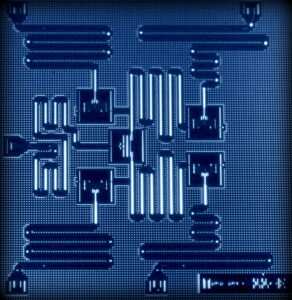Topological quantum computation (TQC) emerges as a revolutionary paradigm that capitalizes on the intriguing properties of topological matter. This article contains the intricacies of topological quantum computation, unraveling its principles, applications, and the profound impact it could have on the future of quantum information processing.
What is topological quantum computation?
TQC is a paradigm of quantum computing that relies on the braiding of anyons, exotic particles with nontrivial topological properties. Quantum information is encoded and processed through braiding operations, providing inherent fault tolerance against local errors.
Unlike conventional gate-based quantum computing, TQC relies on the braiding of anyons, exotic particles with nontrivial topological characteristics, to perform quantum operations.
Also, learn Holonomic Quantum Computation (HQC) [click here]
Foundations of Topological Quantum Computation
1. Topological Matter and Anyons:
At the core of TQC lies the study of topological matter, materials characterized by nontrivial global properties. Anyone, exotic particles that emerge in certain topological phases, play a pivotal role as quantum information carriers.
2. Braiding Operations:
TQC leverages braiding operations, where anyons are exchanged or braided in specific patterns. The outcome of these braiding operations results in a quantum state that encodes information in a fault-tolerant manner, resistant to local errors.
3. Topological Quantum Gates:
Quantum gates in TQC are implemented through braiding anyons. The braiding of anyons induces non-abelian geometric phases, and the resulting unitary transformations serve as building blocks for quantum computation.

Topological Quantum Computation Process
1. Initialization:
The quantum computation process begins with the creation and initialization of anyons, typically in pairs of entangled particles.
2. Braiding Operations:
Anyons are manipulated through braiding operations, where their positions are exchanged in a specific manner. The braiding path defines the unitary transformation, and multiple braiding operations are performed to execute quantum gates.
3. Topologically Protected Quantum Information:
The quantum information encoded in the collective state of braided anyons is inherently protected against local errors. Topological properties ensure that the quantum information remains robust during the computation.
4. Measurement and Quantum Information Retrieval:
Measurements performed on the anyon states reveal the accumulated non-abelian geometric phases, allowing the retrieval of quantum information without compromising its integrity.
Applications and Some Main Challenges
1. Fault-Tolerant Quantum Computation:
TQC excels in fault-tolerant quantum computation. The topological protection offered by braided anyons makes TQC a promising candidate for building large-scale quantum computers resilient to errors.
2. Quantum Memory and Information Storage:
TQC has applications in quantum memory and information storage. The topological nature of the encoded information makes it less susceptible to decoherence, addressing challenges in maintaining quantum states.
3. Challenges in Experimental Realization:
Implementing topological quantum computation faces challenges in experimentally realizing and manipulating anyone. Creating and braiding anyons in a controlled manner demands sophisticated experimental techniques and platforms.
Conclusion
Topological quantum computation, with its reliance on braided anyons and the inherent protection against errors, represents a promising frontier in the quest for scalable and fault-tolerant quantum computing.
Also, learn Adiabatic Quantum Computing (AQC) [click here]
Frequently Asked Questions (FAQs)
What is topological quantum computation?
Ans- Topological quantum computation is a paradigm of quantum computing that relies on the braiding of anyons, exotic particles with nontrivial topological properties. Quantum information is encoded and processed through braiding operations, providing inherent fault tolerance against local errors.
How does topological quantum computation work?
Ans- Topological quantum computation works by manipulating anyons through braiding operations. The braiding of anyons induces non-abelian geometric phases, and quantum gates are implemented through these braiding operations. The resulting topological protection makes TQC resilient to errors.
What are anyons in topological quantum computation?
Ans- Anyons are exotic particles that emerge in certain topological phases of matter. In topological quantum computation, anyons serve as quantum information carriers. Braiding anyons induces non-abelian geometric phases, providing a foundation for fault-tolerant quantum computation.
What are the applications of topological quantum computation?
Ans-Topological quantum computation excels in fault-tolerant quantum computation, making it suitable for large-scale quantum computers. Applications include quantum memory, information storage, and potential use in quantum communication protocols due to the topological protection against errors.
